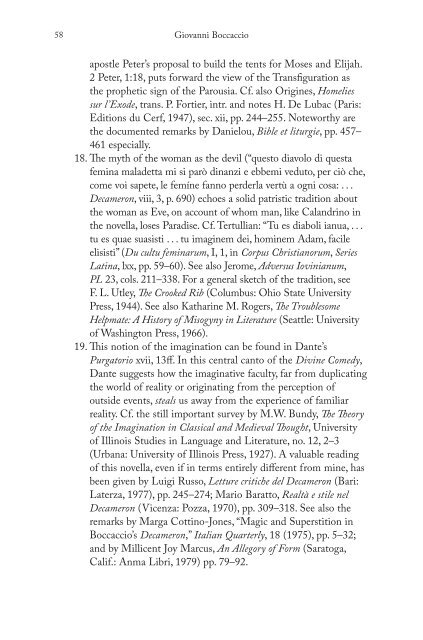Blooms Literary Themes - THE TRICKSTER.pdf - ymerleksi - home
Blooms Literary Themes - THE TRICKSTER.pdf - ymerleksi - home
Blooms Literary Themes - THE TRICKSTER.pdf - ymerleksi - home
You also want an ePaper? Increase the reach of your titles
YUMPU automatically turns print PDFs into web optimized ePapers that Google loves.
58<br />
Giovanni Boccaccio<br />
apostle Peter’s proposal to build the tents for Moses and Elijah.<br />
2 Peter, 1:18, puts forward the view of the Transfi guration as<br />
the prophetic sign of the Parousia. Cf. also Origines, Homelies<br />
sur l’Exode, trans. P. Fortier, intr. and notes H. De Lubac (Paris:<br />
Editions du Cerf, 1947), sec. xii, pp. 244–255. Noteworthy are<br />
the documented remarks by Danielou, Bible et liturgie, pp. 457–<br />
461 especially.<br />
18. Th e myth of the woman as the devil (“questo diavolo di questa<br />
femina maladetta mi si parò dinanzi e ebbemi veduto, per ciò che,<br />
come voi sapete, le femíne fanno perderla vertù a ogni cosa: . . .<br />
Decameron, viii, 3, p. 690) echoes a solid patristic tradition about<br />
the woman as Eve, on account of whom man, like Calandrino in<br />
the novella, loses Paradise. Cf. Tertullian: “Tu es diaboli ianua, . . .<br />
tu es quae suasisti . . . tu imaginem dei, hominem Adam, facile<br />
elisisti” (Du cultu feminarum, I, 1, in Corpus Christianorum, Series<br />
Latina, lxx, pp. 59–60). See also Jerome, Adversus Iovinianum,<br />
PL 23, cols. 211–338. For a general sketch of the tradition, see<br />
F. L. Utley, Th e Crooked Rib (Columbus: Ohio State University<br />
Press, 1944). See also Katharine M. Rogers, Th e Troublesome<br />
Helpmate: A History of Misogyny in Literature (Seattle: University<br />
of Washington Press, 1966).<br />
19. Th is notion of the imagination can be found in Dante’s<br />
Purgatorio xvii, 13ff . In this central canto of the Divine Comedy,<br />
Dante suggests how the imaginative faculty, far from duplicating<br />
the world of reality or originating from the perception of<br />
outside events, steals us away from the experience of familiar<br />
reality. Cf. the still important survey by M.W. Bundy, Th e Th eory<br />
of the Imagination in Classical and Medieval Th ought, University<br />
of Illinois Studies in Language and Literature, no. 12, 2–3<br />
(Urbana: University of Illinois Press, 1927). A valuable reading<br />
of this novella, even if in terms entirely diff erent from mine, has<br />
been given by Luigi Russo, Letture critiche del Decameron (Bari:<br />
Laterza, 1977), pp. 245–274; Mario Baratto, Realtà e stile nel<br />
Decameron (Vicenza: Pozza, 1970), pp. 309–318. See also the<br />
remarks by Marga Cottino-Jones, “Magic and Superstition in<br />
Boccaccio’s Decameron,” Italian Quarterly, 18 (1975), pp. 5–32;<br />
and by Millicent Joy Marcus, An Allegory of Form (Saratoga,<br />
Calif.: Anma Libri, 1979) pp. 79–92.

















